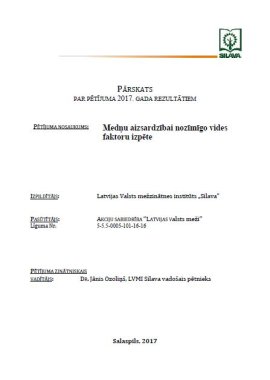Medņu aizsardzībai nozīmīgo vides faktoru izpēte 2017

Pētījuma “Medņu aizsardzībai nozīmīgo vides faktoru izpēte” otrajā etapā veikti 5 uzdevumi. (1) Zīdītāju un putnu uzskaites izvēlētajos 15 riestos, katrā atkārtojot uzskaiti trīs reizes atšķirīgās sezonās. (2) Medņu dabisko ienaidnieku – meža caunu - ietekmes novērtējums. (3) Medņu ģenētiskās daudzveidības rādītāju salīdzinājums starp Kurzemes un Vidzemes populācijām. (4) Traucējumu ietekmes pārbaudes uzsākšana uz medņu uzvedību. (5) Aizsargājamo meža biotopu inventarizācija un kvalitātes novērtēšana riestu teritorijās.
Medņu riestu teritorijās visbiežāk konstatētie zīdītāji 2017. gadā bijuši staltbrieži, stirnas un aļņi. Meža cūku skaits, salīdzinot ar 2016. gadu, ievērojami samazinājies. No plēsējiem visbiežāk sastopama meža cauna. Putnu faunā konstatētas 80 sugas, no kurām vislielākā skaitā sastopami čuņčiņš, koku čipste, sarkanrīklīte, svirlītis, vītītis un žubīte. Lielāka putnu sugu daudzveidība konstatēta medņu riestos, kas atrodas Vidzemes novadā, mazāka – Sēlijas novadā. Laikā pirms medņu riestošanas konstatētas atšķirības putnu sugu daudzveidībā (Šenona indekss, Shaennon index) starp riestu centrālo daļu, kuru medņu gaiļi faktiski apmeklē riestošanas procesā, un riestu pārējo teritoriju. Centrālajā daļā šajā laikā sugu daudzveidība ir mazāka nekā perifērijā. Sākoties medņu riestošanai un ligzdošanai, sugu daudzveidība starp abām zonām izlīdzinās.
Putniem meža caunu barībā ir salīdzinoši neliela loma - pēc absolūtā sastopamības biežuma ekskrementos tikai 3,5% gadījumu. Taču barojoties ar sīkajiem zīdītājiem un meža ogām, tās kā barību izmanto arī pieejamos putnus, tajā skaitā medņus. Tādēļ liels meža caunu skaits un pastāvīga to klātbūtne jāuzskata medņiem par apdraudējumu, īpaši to ligzdošanas un cāļu vadāšanas periodā.
Ģenētiskajā analīzē, izmantojot 7 mikrosatelītu marķierus, pārbaudīts no medņu spalvām izdalīts DNS 53 indivīdiem Vidzemes populācijā un 15 indivīdiem Kurzemes populācijā. Ņemot vērā pieejamo paraugu skaita atšķirības, ģenētiskās daudzveidības rādītāji starp populācijām neparāda būtiskas atšķirības. Vidējā savstarpējā radniecība starp katru pārbaudīto indivīdu pāri abu grupu ietvaros nav augsta, kas liecina, ka abas populācijas ir pietiekami lielas, lai izvairītos no tuvradnieciskas krustošanās.
Izraudzīta un iegādāta aparatūra medņu reakcijas pētījumiem ar telemetrijas metodi uz cilvēku radītu traucējumu. Iepazīta labākā pieredze putnu sagūstīšanā un raidītāju uzstādīšanā.
Aizsargājamo meža biotopu kvalitāte medņu riestos vērtēta, izmantojot 22 kritērijus un summējot par katru kritēriju iegūtos punktus. Kopumā riestos 1039,41 ha mežu (81,92% no pārbaudītās platības) atbilst Eiropas Savienības nozīmes aizsargājamiem meža biotopiem. Kvalitātes ziņā lielākā daļa biotopu novērtēti kā vidēji. Izcilas kvalitātes biotopi ir 4% no kopējās attiecīgajam biotopam atbilstošās platības. Labas kvalitātes biotopi ir 30%.
Summary
In the second stage of the study "Examination of important environmental factors for conservation of capercaillie" 5 tasks were performed. (1) Mammal and bird inventories in 15 selected leks, repeated three times in different seasons. (2) Assessment of the impact of pine martens - a natural predator of capercaillie. (3) Comparison of genetic diversity and differentiation indicators in the Kurzeme and Vidzeme capercaillie subpopulations. (4) Initiation of a survey of the impact of disturbance on the behaviour of capercaillie. (5) Inventory and quality assessment of protected forest habitats within the territory of leks.
In 2017, the mammals most commonly found in capercaillie lek territories were red deer, roe deer and elk. Compared to 2016, the number of wild boar had decreased significantly. Pine marten was the most frequent predator species. 80 bird species were identified, of which the most common were chiffchaff, tree pipit, European robin, wood warbler, willow warbler and chaffinch. The greatest diversity of bird species was found in capercaillie leks located in the Vidzeme region, and the smallest in the Selija region. Prior to the lekking period, differences in bird species’ diversity (Shannon index) was detected between the central parts of leks, which are more frequented by male capercaillie during the lekking process, and the rest of the lek territory. During this period, species diversity is smaller in the central part of the lek than at the periphery. As the capercaillie lekking and nesting period begins, the species diversity between the two zones equalises.
Bird species form a relatively small proportion in the diet of pine martens, with an absolute occurrence of only 3.5% in excrements. However, while eating small mammals and wild berries, martens also use to prey on available birds, including capercaillie. Therefore, a large number of pine martens and their persistent presence should be considered as a threat to capercaillie, especially during the nesting and chick rearing period.
In a genetic analysis using 7 microsatellite markers, DNA extracted from capercaillie feathers of 53 individuals from the Vidzeme subpopulation and 15 individuals from the Kurzeme subpopulation was genotyped. Taking into account the differences in the number of analysed individuals in each population, no significant differences in genetic diversity between the two subpopulations were found. The average pairwise relatedness between individuals within each of the two subpopulations was not high, which suggests that both subpopulations are sufficiently large enough to avoid inbreeding.
The equipment for the telemetric study of capercaillie reactions to human-induced disturbances was selected and purchased. Best practices for bird capture and transmitter installation were assessed.
The quality of protected forest habitats in capercaillie leks was evaluated by summing the points obtained for each of 22 criteria. In total, 1039.41 ha of forest within leks (81.92% of the tested area) correspond to protected forest biotopes of European significance. In terms of quality, most biotopes were assessed as average. Excellent quality biotopes were found in 4% of the total area of the corresponding relevant biotope, and good quality habitats comprise 30%.




